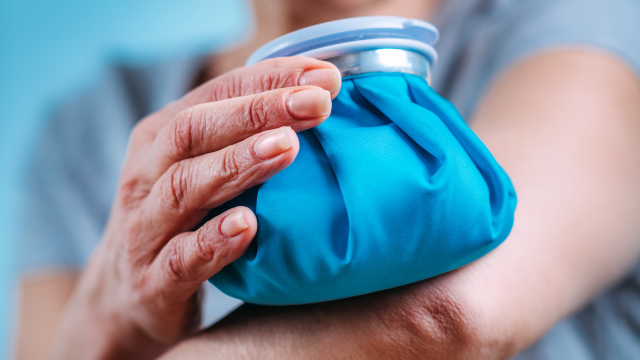Updated on January 6, 2025.
When rheumatoid arthritis (RA) pain arises, it’s tempting to head straight to the medicine cabinet for relief. And who would question you? The joint pain, swelling, and bodily fatigue that characterizes RA could sideline you for hours, days, weeks, or even longer.
While doctor-prescribed medication is your best line of defense against RA pain, there are a variety of drug-free treatments that may also help you get relief.
Consider your diet
Help strengthen aching joints by reconsidering what you eat and drink. Foods common in the average Western diet can increase inflammation, including red and processed meat, refined carbohydrates, and sugar-sweetened drinks.
Instead, try foods that may help lessen inflammation. Research suggests that a diet based on whole foods and plants can improve joint pain, swelling, and morning stiffness in people with RA. Eating a vegetarian or vegan diet, in particular, may ease symptoms and inflammation. These diets can also lead to modest weight loss—and moving toward a healthy weight is linked to better symptom relief. Be sure to speak with a healthcare provider (HCP) if you plan on going vegan or vegetarian, however, since certain vitamin supplements may be necessary.
The Mediterranean diet and the Dietary Approaches to Stop Hypertension (DASH) diet are both similarly focused on whole foods and plants, but include some lean meats and fish. Both of these diets are tied to anti-inflammatory benefits.
One of the reasons a whole-foods- and plant-focused diet can help is that they are usually high in fiber and low in saturated fat, which is associated with less pain, swelling, and inflammation. The high antioxidant content of fruits and different-colored veggies can also help protect joint tissue and reduce inflammation.
Start moving
It may sound counterintuitive, but motion can benefit your joints. Physical exercise helps to reduce joint pain and increase mobility and range of motion. The right RA exercises also help to build protective muscle around joints made weaker by the condition.
The key is to go with low-impact workouts such as walking, bike riding, swimming, water aerobics, or weight training with light weights. They’ll keep you moving without putting too much strain on your joints or raising your risk for injury. Start out slow and increase your distance and pace over time. It's especially important to start every workout with stretching exercises to stay flexible.
Mind-body practices may be especially helpful. Yoga and tai chi combine gentle movement with deep breathing and meditation, all beneficial for RA. Just remember—with any exercise you try, listen to your body and scale back when you're having a flare-up or feel fatigued. Don’t quit entirely. Just slow down and shorten your exercise sessions.
Try alternative and complementary treatments
When RA pain begins to flare up, you may want to consider massage. When done correctly with moderate pressure, there is some evidence it might help to lower pain. If you try it, be sure to avoid vigorous massage styles like deep tissue massage, as it may be harmful for people with RA. Also, use a practitioner who has experience working with people with RA.
Mindfulness meditation, which involves focusing intently on the present, is also linked to less RA pain. But it’s important to watch your comfort levels and adjust. Often, meditation involves sitting still for a long period of time, which can be difficult for people with RA.
Thermotherapy, or applying heat to painful areas, is another simple way to potentially soothe sore joints. Heating pads, a warm bath with steam, or hot towels are good options for warmth. When your joint or muscle warms up, the blood vessels expand. This allows better circulation to the sore area, which can help relax the tissues.
That said, if you’re injured or having a flare of swelling and redness, avoid heat. Instead, it’s best to use a cold treatment like an ice pack to lower blood flow and inflammation.
Consult with your HCP about supplements
Most supplements touted as helpful for RA have undergone little or no scientific scrutiny. They need much more rigorous study before they can be considered both safe and effective.
There is some evidence that omega-3 fatty acid supplements may help improve RA symptoms, though it’s best to get necessary omega-3s through food. Good dietary sources of the nutrient include:
- Flaxseeds and flaxseed oil
- Chia seeds
- Walnuts
- Fatty fish, such as salmon, herring, mackerel, and tuna
- Canola and soybean oil
It’s important to speak with your HCP before trying any supplements, not least because some may cause harmful side effects. The U.S. Food and Drug Administration (FDA) also reports that some supplements marketed to people with RA are tainted with prescription drugs.
Quit smoking
Smoking harms your health. Among its many drawbacks, it causes inflammation throughout the body. Since inflammation is a primary trigger for arthritis, smoking is linked to painful RA symptoms like joint inflammation, swelling, and tenderness. Not only that, but smoking can make medical treatments for arthritis less effective.
Studies have also shown that cigarette smoking can increase the risk for developing RA.
Speak with an HCP about the best way to quit for you. They can help you navigate the options, ranging from nicotine gum and patches to cognitive behavioral therapy.
While there are many options for treating your RA pain, always follow the medical treatments advised by your HCP. Talk to them about whether these additional approaches could work as part of your RA treatment plan.






